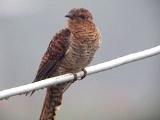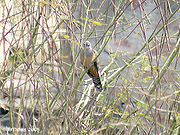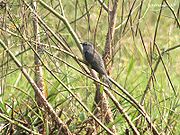
Plaintive Cuckoo
Encyclopedia
The Plaintive Cuckoo is a species of bird
belonging to the genus Cacomantis
in the cuckoo
family Cuculidae. It is native to Asia
, from India
and China
to Indonesia
.
_i_img_7627.jpg)

 It is a fairly small cuckoo, 21-23.5 centimetres long. The adult male is grey-brown above and orange below with a grey head, throat and upper breast. There are white tips to the tail feathers. The legs and feet are yellow, the eye is red and the bill
It is a fairly small cuckoo, 21-23.5 centimetres long. The adult male is grey-brown above and orange below with a grey head, throat and upper breast. There are white tips to the tail feathers. The legs and feet are yellow, the eye is red and the bill
is black above and yellow below. The adult female is sometimes similar to the male but often occurs in a "hepatic" morph
. This form is reddish-brown above with dark bars. The underparts are paler with fainter barring. There is a pale stripe over the eye and the tail has dark bars along its whole length. Juvenile
birds are similar to hepatic females but are paler and have dark streaks rather than bars on the crown and throat.
The male has several plaintive whistling calls. These include an ascending series of three-note phrases and a series of 11 or 12 descending notes.
. The nominate form C. m. merulinus is found in the Philippines
where it is common on many of the larger islands. C. m. querulus is the most widespread form, occurring in north-east India, Bangladesh
, southern China, Myanmar
, Thailand
, Cambodia
, Laos
and Vietnam
. It is a summer visitor to most of its Chinese range, migrating
south for the winter. C. m. threnodes is found in the Malay Peninsula
, Sumatra
and Borneo
while C. m. lanceolatus occurs in Java
, Bali
and Sulawesi
.
The Grey-bellied Cuckoo
(C. passerinus) was formerly classified as a subspecies of the Plaintive Cuckoo but is now often treated as a separate species.
edge, open woodland
, scrub, grassland
, farmland
, parks and gardens. It feeds on invertebrate
s. It is normally solitary and is often difficult to see.
It is a brood parasite
, laying its eggs
in the nest
s of cisticola
s, prinia
s and tailorbird
s. The eggs are similar to those of the host species but are larger. Small birds often mob
the cuckoo to drive it away from their nests.
Bird
Birds are feathered, winged, bipedal, endothermic , egg-laying, vertebrate animals. Around 10,000 living species and 188 families makes them the most speciose class of tetrapod vertebrates. They inhabit ecosystems across the globe, from the Arctic to the Antarctic. Extant birds range in size from...
belonging to the genus Cacomantis
Cacomantis
Cacomantis is a genus of cuckoo in the Cuculidae family. The genus name is derived from the Greek kakos meaning evil or ill-boding and mantis for prophet and is derived from their association with "rains" being supposed to be predict ill fortune and bad weather. Most of them have a round nostril...
in the cuckoo
Cuckoo
The cuckoos are a family, Cuculidae, of near passerine birds. The order Cuculiformes, in addition to the cuckoos, also includes the turacos . Some zoologists and taxonomists have also included the unique Hoatzin in the Cuculiformes, but its taxonomy remains in dispute...
family Cuculidae. It is native to Asia
Asia
Asia is the world's largest and most populous continent, located primarily in the eastern and northern hemispheres. It covers 8.7% of the Earth's total surface area and with approximately 3.879 billion people, it hosts 60% of the world's current human population...
, from India
India
India , officially the Republic of India , is a country in South Asia. It is the seventh-largest country by geographical area, the second-most populous country with over 1.2 billion people, and the most populous democracy in the world...
and China
China
Chinese civilization may refer to:* China for more general discussion of the country.* Chinese culture* Greater China, the transnational community of ethnic Chinese.* History of China* Sinosphere, the area historically affected by Chinese culture...
to Indonesia
Indonesia
Indonesia , officially the Republic of Indonesia , is a country in Southeast Asia and Oceania. Indonesia is an archipelago comprising approximately 13,000 islands. It has 33 provinces with over 238 million people, and is the world's fourth most populous country. Indonesia is a republic, with an...
.
Description
_i_img_7627.jpg)


Beak
The beak, bill or rostrum is an external anatomical structure of birds which is used for eating and for grooming, manipulating objects, killing prey, fighting, probing for food, courtship and feeding young...
is black above and yellow below. The adult female is sometimes similar to the male but often occurs in a "hepatic" morph
Polymorphism (biology)
Polymorphism in biology occurs when two or more clearly different phenotypes exist in the same population of a species — in other words, the occurrence of more than one form or morph...
. This form is reddish-brown above with dark bars. The underparts are paler with fainter barring. There is a pale stripe over the eye and the tail has dark bars along its whole length. Juvenile
Juvenile (organism)
A juvenile is an individual organism that has not yet reached its adult form, sexual maturity or size. Juveniles sometimes look very different from the adult form, particularly in terms of their colour...
birds are similar to hepatic females but are paler and have dark streaks rather than bars on the crown and throat.
The male has several plaintive whistling calls. These include an ascending series of three-note phrases and a series of 11 or 12 descending notes.
Distribution and subspecies
There are four subspeciesSubspecies
Subspecies in biological classification, is either a taxonomic rank subordinate to species, ora taxonomic unit in that rank . A subspecies cannot be recognized in isolation: a species will either be recognized as having no subspecies at all or two or more, never just one...
. The nominate form C. m. merulinus is found in the Philippines
Philippines
The Philippines , officially known as the Republic of the Philippines , is a country in Southeast Asia in the western Pacific Ocean. To its north across the Luzon Strait lies Taiwan. West across the South China Sea sits Vietnam...
where it is common on many of the larger islands. C. m. querulus is the most widespread form, occurring in north-east India, Bangladesh
Bangladesh
Bangladesh , officially the People's Republic of Bangladesh is a sovereign state located in South Asia. It is bordered by India on all sides except for a small border with Burma to the far southeast and by the Bay of Bengal to the south...
, southern China, Myanmar
Myanmar
Burma , officially the Republic of the Union of Myanmar , is a country in Southeast Asia. Burma is bordered by China on the northeast, Laos on the east, Thailand on the southeast, Bangladesh on the west, India on the northwest, the Bay of Bengal to the southwest, and the Andaman Sea on the south....
, Thailand
Thailand
Thailand , officially the Kingdom of Thailand , formerly known as Siam , is a country located at the centre of the Indochina peninsula and Southeast Asia. It is bordered to the north by Burma and Laos, to the east by Laos and Cambodia, to the south by the Gulf of Thailand and Malaysia, and to the...
, Cambodia
Cambodia
Cambodia , officially known as the Kingdom of Cambodia, is a country located in the southern portion of the Indochina Peninsula in Southeast Asia...
, Laos
Laos
Laos Lao: ສາທາລະນະລັດ ປະຊາທິປະໄຕ ປະຊາຊົນລາວ Sathalanalat Paxathipatai Paxaxon Lao, officially the Lao People's Democratic Republic, is a landlocked country in Southeast Asia, bordered by Burma and China to the northwest, Vietnam to the east, Cambodia to the south and Thailand to the west...
and Vietnam
Vietnam
Vietnam – sometimes spelled Viet Nam , officially the Socialist Republic of Vietnam – is the easternmost country on the Indochina Peninsula in Southeast Asia. It is bordered by China to the north, Laos to the northwest, Cambodia to the southwest, and the South China Sea –...
. It is a summer visitor to most of its Chinese range, migrating
Bird migration
Bird migration is the regular seasonal journey undertaken by many species of birds. Bird movements include those made in response to changes in food availability, habitat or weather. Sometimes, journeys are not termed "true migration" because they are irregular or in only one direction...
south for the winter. C. m. threnodes is found in the Malay Peninsula
Malay Peninsula
The Malay Peninsula or Thai-Malay Peninsula is a peninsula in Southeast Asia. The land mass runs approximately north-south and, at its terminus, is the southern-most point of the Asian mainland...
, Sumatra
Sumatra
Sumatra is an island in western Indonesia, westernmost of the Sunda Islands. It is the largest island entirely in Indonesia , and the sixth largest island in the world at 473,481 km2 with a population of 50,365,538...
and Borneo
Borneo
Borneo is the third largest island in the world and is located north of Java Island, Indonesia, at the geographic centre of Maritime Southeast Asia....
while C. m. lanceolatus occurs in Java
Java
Java is an island of Indonesia. With a population of 135 million , it is the world's most populous island, and one of the most densely populated regions in the world. It is home to 60% of Indonesia's population. The Indonesian capital city, Jakarta, is in west Java...
, Bali
Bali
Bali is an Indonesian island located in the westernmost end of the Lesser Sunda Islands, lying between Java to the west and Lombok to the east...
and Sulawesi
Sulawesi
Sulawesi is one of the four larger Sunda Islands of Indonesia and is situated between Borneo and the Maluku Islands. In Indonesia, only Sumatra, Borneo, and Papua are larger in territory, and only Java and Sumatra have larger Indonesian populations.- Etymology :The Portuguese were the first to...
.
The Grey-bellied Cuckoo
Grey-bellied Cuckoo
The Grey-bellied Cuckoo or the Indian Plaintive Cuckoo, Cacomantis passerinus, is a member of the cuckoo order of birds, the Cuculiformes, which also includes the roadrunners, the anis, and the Hoatzin....
(C. passerinus) was formerly classified as a subspecies of the Plaintive Cuckoo but is now often treated as a separate species.
Ecology
The Plaintive Cuckoo inhabits forestForest
A forest, also referred to as a wood or the woods, is an area with a high density of trees. As with cities, depending where you are in the world, what is considered a forest may vary significantly in size and have various classification according to how and what of the forest is composed...
edge, open woodland
Woodland
Ecologically, a woodland is a low-density forest forming open habitats with plenty of sunlight and limited shade. Woodlands may support an understory of shrubs and herbaceous plants including grasses. Woodland may form a transition to shrubland under drier conditions or during early stages of...
, scrub, grassland
Grassland
Grasslands are areas where the vegetation is dominated by grasses and other herbaceous plants . However, sedge and rush families can also be found. Grasslands occur naturally on all continents except Antarctica...
, farmland
Arable land
In geography and agriculture, arable land is land that can be used for growing crops. It includes all land under temporary crops , temporary meadows for mowing or pasture, land under market and kitchen gardens and land temporarily fallow...
, parks and gardens. It feeds on invertebrate
Invertebrate
An invertebrate is an animal without a backbone. The group includes 97% of all animal species – all animals except those in the chordate subphylum Vertebrata .Invertebrates form a paraphyletic group...
s. It is normally solitary and is often difficult to see.
It is a brood parasite
Brood parasite
Brood parasites are organisms that use the strategy of brood parasitism, a kind of kleptoparasitism found among birds, fish or insects, involving the manipulation and use of host individuals either of the same or different species to raise the young of the brood-parasite...
, laying its eggs
Egg (biology)
An egg is an organic vessel in which an embryo first begins to develop. In most birds, reptiles, insects, molluscs, fish, and monotremes, an egg is the zygote, resulting from fertilization of the ovum, which is expelled from the body and permitted to develop outside the body until the developing...
in the nest
Bird nest
A bird nest is the spot in which a bird lays and incubates its eggs and raises its young. Although the term popularly refers to a specific structure made by the bird itself—such as the grassy cup nest of the American Robin or Eurasian Blackbird, or the elaborately woven hanging nest of the...
s of cisticola
Cisticola
Cisticolas are a genus of very small insectivorous birds formerly classified in the Old World warbler family Sylviidae, but now usually considered to be in the separate family Cisticolidae, along with other southern warbler genera. They are believed to be quite closely related to the swallows and...
s, prinia
Prinia
The prinias are a genus of small insectivorous birds belonging to the passerine bird family Cisticolidae. They are often also alternatively classed in the Old World warbler family, Sylviidae. The name of the genus is derived from the Javanese prinya, the local name for the Bar-winged Prinia.The...
s and tailorbird
Tailorbird
Tailorbirds are small birds belonging to the genus Orthotomus often placed in the Old World warbler family Sylviidae. However, recent research suggests they more likely belong in the Cisticolidae and they are treated as such in Del Hoyo et al....
s. The eggs are similar to those of the host species but are larger. Small birds often mob
Mobbing behavior
Mobbing in animals is an antipredator behavior which occurs when individuals of a certain species mob a predator by cooperatively attacking or harassing it, usually to protect their offspring. A simple definition of mobbing is an assemblage of individuals around a potentially dangerous predator...
the cuckoo to drive it away from their nests.

